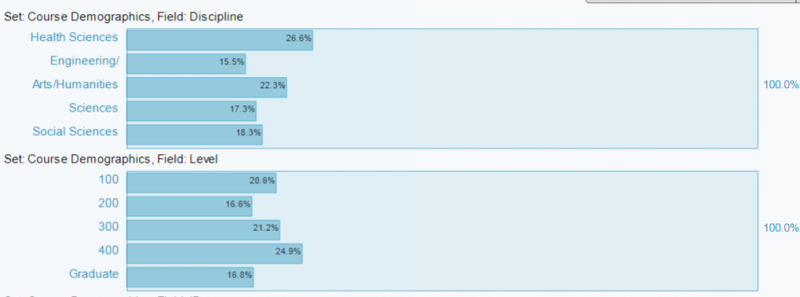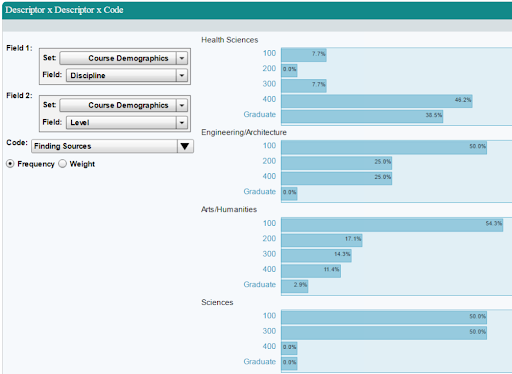Background
Assessing library impact on student learning is essential for demonstrating libraries’ integrated value and commitment to higher education. Every few years University of Michigan Library staff conduct a survey to learn how satisfied faculty are with library instruction sessions. However, in 2018 my colleague, Jo Angela Oehrli, and I really wanted to focus on questions that explore student learning. So we designed and conducted a study to assess student learning in one-time, course-integrated instruction sessions in order to investigate faculty and instructor perceptions of student learning.
Methodology
We designed a survey with several questions to assess faculty perceptions of student learning and satisfaction with library instruction related to the specific goals of their course. Survey recipients were given three statements to respond to on a five point Likert Scale (Strongly Agree, Agree, Neutral, Disagree, Strongly Disagree):
- Students were better able to complete coursework because of this session.
- The instruction session met my learning goals and expectations.
- I would recommend library instruction to other instructors.
Additionally, two open-ended questions focused on obtaining data about specific concepts and skills students learned during the library session, and then how students applied these concepts and skills to improve the quality of their coursework. We used our locally-developed Scheduling App for Library Instruction (SALI) to obtain the email addresses of all campus instructors for whom we taught a session during the 2017-2018 academic year. Surveys were created in Qualtrics and invitations were sent via email to 380 faculty and instructors. A total of 165 faculty completed the survey for a 43% response rate.
Data from faculty responses were analyzed in two ways:
- Quantitative data from the three Likert scale questions were analyzed to identify trends based on course level and discipline.
- Qualitative data from the two open-ended questions were coded for specific themes related to student learning.
Findings
Survey responses were overwhelmingly positive in that faculty strongly state that their students learned valuable concepts and skills from participation in library instruction sessions. They provided examples of specific learning goals and how they determined students achievement toward these goals. 95% of faculty responding to the survey reported that students were better able to complete coursework because of a library instruction session. 98.5% state the instruction session met their learning goals and expectations. 99.4% would recommend library instruction to other instructors.
Code Analysis by Discipline and Course Level
We developed a codebook consisting of 23 codes. We analyzed the five most frequently used in the following charts.
As one might expect, the most frequently used code, Finding Sources, was applied fairly equally across all disciplines and all levels of courses as demonstrated in Figure 1.
Figure 1 - Finding Sources code used by discipline

However upon further examination of course levels within identified disciplines, certain patterns emerged. Most disciplines demonstrate decreasing focus on Finding Sources as course level increases, yet Health Sciences illustrate the opposite pattern of increasing emphasis on Finding Sources as course levels increase (Figure 2).
Figure 2- Finding Sources code used by discipline and course level

Our second most frequently used code, Evaluating Sources, also demonstrated interesting patterns. This topic is taught in a fairly distributed manner throughout the Health Sciences and Social Sciences. In other disciplines, the topic peaks in 100 level courses and shows a very rapid decline in advanced courses. The topic of Library Organization appears throughout the disciplines with the exception of Science courses, where it only appears in 100 level courses. Search Strategy Development, the fourth most used code, is well represented across the Social Sciences and Arts/Humanities disciplines. It peaks in graduate level Health Sciences, only appears in 200 level in Engineering/Architecture, and again, only features in 300 level Sciences. Using and Understanding Sources, the last of the top five codes used, is reflected in most levels of courses in the Arts/Humanities, Sciences, and Social Sciences. Interestingly, Using and Understanding Sources does not appear in graduate level courses in the Sciences or Social Sciences, while conversely, it only appears in graduate level courses for the Health Sciences or Engineering/Architecture.
Practical Implications and Value
On a practical level, the data collected through this study is immensely useful in assessing our library instruction program. Library instructors learned that their teaching practices were effective, and that faculty and instructors perceived improved student learning when students participate in library-related instruction. Analyzing information on faculty learning goals and assessment of student work helps library instructors to understand where faculty place emphasis in their courses, where students could increase knowledge, and a broad range of faculty expectations regarding student achievement. Through analysis of this data, library instructors are better positioned to discuss future student learning needs with faculty in their disciplines.
Moreover, results of this study clearly demonstrated the value that library instruction can bring to the student learning experience. The concepts and skills taught through library instruction are foundational and intrinsic to curricula throughout higher education. When faculty demonstrate the value of library instruction to student learning, other faculty and administrators listen.
For more details about this study, read our full paper, presented at the 2018 Library Assessment Conference.
(Submitted by Doreen Bradley and Jo Angela Oehrli.)